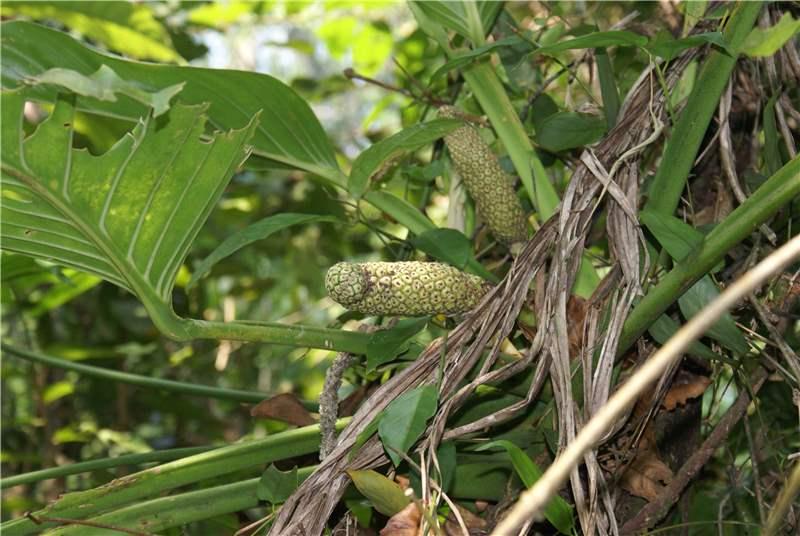Scandent epiphyte 2 – 4 (-6) m tall. Juvenile: terrestrial creeper, stem smooth, green, terete, internodes 1 – 6 cm long; petiole vaginate for 1/3 to 5/6 its length, the lamina widely ovate to narrowly elliptic, entire or perforated at a very early stage when only 5 – 10 cm long. Adult stem: subterete, green, smooth, 1.5 – 3.0 cm thick, the internodes 3 – 10 cm long; leaf scars shallow, 3 – 10 mm wide at the widest point, the ends of each leaf scar overlapping for 3 – 6 mm; axillary buds longer than wide, located in a depression which is not extended into a sulcus. Petiole: smooth, 20 – 60 cm long, somewhat shorter than the lamina, vaginate to the geniculum, the wings of the sheath deciduous or persistent, the geniculum 3 – 5 cm long. Lamina: subcoriaceous, glossy adaxially, very widely ovate to elliptic, 25 – 70 cm long, 15 – 45 cm wide, the base cuneate to broadly truncate, sometimes oblique and unequal, being cuneate on one side and truncate to subcordate on the other side, the tip acute or shortly mucronate; margin entire, rarely irregularly laciniate, perforations absent to numerous in several series on each side of the midrib; primary lateral veins parallel, 8 – 16 in number, secondary lateral veins parallel to the primaries. Peduncle: smooth, green, subterete to flattened, 9 – 22 cm long, 1.0 – 1.4 cm thick, 1.1 – 2.0 cm wide. Spathe: cream to pale yellow, coriaceous, 12 – 28 cm tall, 10 – 25 cm around, acuminate, opening widely at maturity. Flowering spadix: cream to yellow,cylindric, 8 – 13 cm long, 1.1 – 2.6 cm thick, the pistils 4 – 7 mm long, truncate or acute at the apex, the lower 6 – 8 rows of flowers sterile. Fruiting spadix: green, becoming yellow to deep yellow at maturity, 10 – 17 cm long, 2 – 4 cm thick, the stylar portion of the pistil containing trichosclereids, deciduous, revealing the seeds in a gray pulp. Berries mostly one-seeded, the seeds brown or black, 5 – 7 mm long, 4 – 6 mm wide, 2 – 3 mm thick.
Madison (1977: 36)









